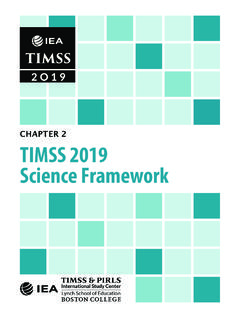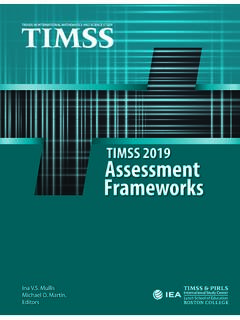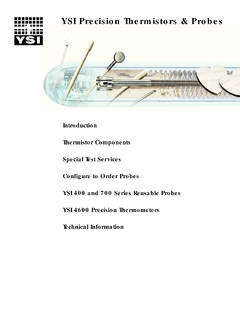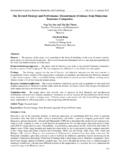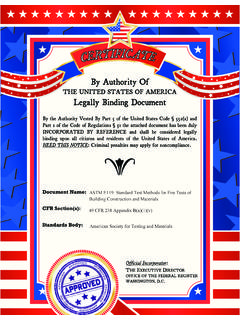Transcription of CHAPTER 1 TIMSS 2019 Mathematics Framework
1 TIMSS & PIRLSL ynch School of EducationInternational Study CenterCHAPTER 1 TIMSS 2019 Mathematics FrameworkTIMSS & PIRLSL ynch School of EducationInternational Study Center TIMSS 2019 Mathematics Framework 13 CHAPTER 1 TIMSS 2019 Mathematics FrameworkMary Lindquist Ray Philpot Ina Mullis Kerry E. CotterOverviewAll children can benefit from developing strong skills in and a deep understanding of Mathematics . Primarily, learning Mathematics improves problem solving skills, and working through problems can teach persistence and perseverance. Mathematics is essential in daily life for such activities as counting, cooking, managing money, and building things.
2 Beyond that, many career fields require a strong mathematical foundation, such as engineering, architecture, accounting, banking, business, medicine, ecology, and aerospace. Mathematics is vital to economics and finance, as well as to the computing technology and software development underlying our technologically advanced and information based world. This CHAPTER presents the assessment frameworks for the two TIMSS 2019 Mathematics assessments: TIMSS Mathematics Fourth Grade TIMSS Mathematics Eighth GradeAs described in the Introduction, the TIMSS 2019 Mathematics Frameworks for the fourth and eighth grades build on TIMSS 24-year history of assessments every four years since 1995, with this being the seventh assessment in the series.
3 In general, the fourth and eighth grade frameworks are similar to those used in TIMSS 2015. However, there have been minor updates to particular topics to better reflect the curricula, standards, and frameworks of the participating countries as reported in the TIMSS 2015 Encyclopedia (Mullis, Martin, Goh, & Cotter, 2016). Also, because TIMSS 2019 focuses on the transition to eTIMSS, the Mathematics frameworks have been updated and are appropriate for both digital and paper assessment formats. The goal is to capitalize on the benefits of computer-based assessment to begin incorporating new and better assessment methods, especially in the applying and reasoning domains (see CHAPTER 4).
4 TIMSS & PIRLSL ynch School of EducationInternational Study Center TIMSS 2019 Mathematics Framework 14 Each of the two assessment frameworks for TIMSS 2019 is organized around two dimensions : Content dimension, specifying the subject matter to be assessed Cognitive dimension, specifying the thinking processes to be assessedExhibit shows the target percentage of testing time devoted to each content and cognitive domain for the TIMSS 2019 fourth and eighth grade : Target Percentages of the TIMSS 2019 Mathematics Assessment Devoted to Content and Cognitive Domains at the Fourth and Eighth GradesFourth GradeContent DomainsPercentagesNumber50%Measurement and Geometry30%Data20%Eighth GradeContent DomainsPercentagesNumber30%Algebra30%Geo metry20%Data and Probability20%Cognitive DomainsPercentagesFourth GradeEighth GradeKnowing40%35%Applying40%40%Reasonin g20%25%The content domains differ for the fourth and eighth grades, reflecting the Mathematics widely taught at each grade.
5 There is more emphasis on number at the fourth grade than at the eighth grade. At the eighth grade, two of the four content domains are algebra and geometry. Because these generally are not taught as separable areas in primary school, the introductory or prealgebra topics assessed at the fourth grade are included as part of number. The fourth grade data domain focuses on collecting, reading, and representing data, whereas at the eighth grade it includes more emphasis on interpretation of data, basic statistics, and the fundamentals of probability. It is important to highlight that TIMSS assesses a range of problem solving situations within Mathematics , with about two-thirds of the items requiring students to use applying and reasoning skills.
6 The cognitive domains are the same for both grades, but with a shift in emphasis. Compared to TIMSS & PIRLSL ynch School of EducationInternational Study Center TIMSS 2019 Mathematics Framework 15the fourth grade, the eighth grade has less emphasis on the knowing domain and greater emphasis on the reasoning domain. Following this brief introduction, the CHAPTER begins with the fourth grade content domains, identifying the three main content domains and the assessment topics within each domain. Next, CHAPTER 1 continues with the description of the TIMSS Mathematics Eighth Grade content domains and, then, the descriptions of the cognitive domains for both the fourth and eighth Content Domains Fourth Grade Exhibit shows the TIMSS Mathematics Fourth Grade content domains and the target percentages of assessment score points devoted to each.
7 Each content domain consists of topic areas, and each topic area in turn includes several topics. Across the fourth grade Mathematics assessment, each topic receives approximately equal weight. Exhibit : Target Percentages of the TIMSS 2019 Mathematics Assessment Devoted to Content Domains at the Fourth GradeFourth Grade Content DomainsPercentagesNumber50%Measurement and Geometry30%Data20%Number Number provides the foundation of Mathematics in primary school. The number content domain consists of three topic areas. The fifty percent of the assessment devoted to number is apportioned as follows: Whole numbers (25%) Expressions, simple equations, and relationships (15%) Fractions and decimals (10%)Whole numbers are the predominant component of the number domain and students should be able to compute with whole numbers of reasonable size as well as use computation to solve problems.
8 Prealgebra concepts also are part of the TIMSS assessment at the fourth grade, including understanding the concept of variable (unknowns) in simple equations, and initial understandings of relationships between quantities. However, because objects and quantities often do not come in whole numbers, it is also important for students to understand fractions and decimals. Students should be able to compare, add, and subtract familiar fractions and decimals to solve & PIRLSL ynch School of EducationInternational Study Center TIMSS 2019 Mathematics Framework 16 Whole Numbers1. Demonstrate knowledge of place value (2-digit to 6-digit numbers); represent whole numbers with words, diagrams, number lines, or symbols; order Add and subtract (up to 4-digit numbers), including computation in simple contextual Multiply (up to 3-digit by 1-digit and 2-digit by 2-digit numbers) and divide (up to 3-digit by 1-digit numbers), including computation in simple contextual Solve problems involving odd and even numbers, multiples and factors of numbers, rounding numbers (up to the nearest ten thousand), and making Combine two or more properties of numbers or operations to solve problems in , Simple Equations, and Relationships1.
9 Find the missing number or operation in a number sentence ( , 17 + w = 29).2. Identify or write expressions or number sentences to represent problem situations that may involve Identify and use relationships in a well-defined pattern ( , describe the relationship between adjacent terms and generate pairs of whole numbers given a rule).Fractions and Decimals1. Recognize fractions as parts of wholes or collections; represent fractions using words, numbers, or models; compare and order simple fractions; add and subtract simple fractions, including those set in problem situations. (Fractions may have denominators of 2, 3, 4, 5, 6, 8, 10, 12, or 100.)2. Demonstrate knowledge of decimal place value including representing decimals using words, numbers, or models; compare, order, and round decimals; add and subtract decimals, including those set in problem situations.
10 (Decimals may have one or two decimal places, allowing for computations with money.)Measurement and GeometryWe are surrounded by objects of different shapes and sizes, and geometry helps us visualize and understand the relationships between shapes and sizes. Measurement is the process of quantifying attributes of objects and phenomena ( , length and time).The two topic areas in measurement and geometry are as follows: Measurement (15%) Geometry (15%) TIMSS & PIRLSL ynch School of EducationInternational Study Center TIMSS 2019 Mathematics Framework 17At the fourth grade, students should be able to use a ruler to measure length; solve problems involving length, mass, capacity, and time; calculate areas and perimeters of simple polygons; and use cubes to determine volumes.
